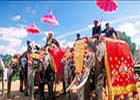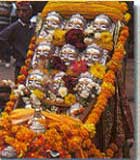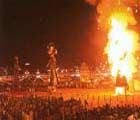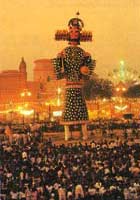Dusserah is celebrated in remembrance of the victory of Rama over Ravana. Burning of the effigy of Ravana on the Vijaya Dashami day means to get rid of the evils in a man. On the 10th day, larger than life effigies of Ravana, his brothers Meghanath and Kumbhakarna filled with different fire crackers are set alight to celebrate the victory of good over evil.
Dussehra is celebrated to mark the home coming of Lord Rama. Rama was known for his strict abidance to truth, virtue and righteousness. Rama symbolizes a perfect life and those who follow the path laid by him will enjoy peace.
Ram Lila begins on the first day of Navaratris, when the enactment of Rama Drama begins. The Ram Lila drama centres on the life of Lord Rama.
The following Dusserah fairs are famous for their magnificence, although every place in India, celebrates the fair, in one form or the other:
- The Rama Barat of Agra, marriage procession of Rama, from Ayodhaya toJanakpur, the capital city of Janaka, the father of Sita, is famous, which attracts crowds from all nearby places, who come in thousands.
- In Himachal Pradesh, a week long fair at Kullu is a part of the Dussehra celebrations. The festival begins with the pulling of the chariot of Lord Raghunath from the Raghunath temple, by hundreds of devotees through the townsship. The various local deities, worshipped in different parts of the valley and the adjoining areas, follow the chariot. After the weeklong celebrations, follows the sacrifice of a buffalo, a rooster, a lamb, a fish and a crab. Simultaneously a huge pile of grass is set on fire symbolizing the burning of Lanka (the evil).
- Mysore is illuminated with lights for Dussehra. Mejestic processions, a torch light parade and dance and musical enliven the tranquil city.
- In Kashi, Ram Lila is performed at many places. Parayag, on the day of Vijaya Dashami, many decorated tableaux are taken through the streets. The Ram Lila in Ram Nagar of Kashi, lasts for one month.






